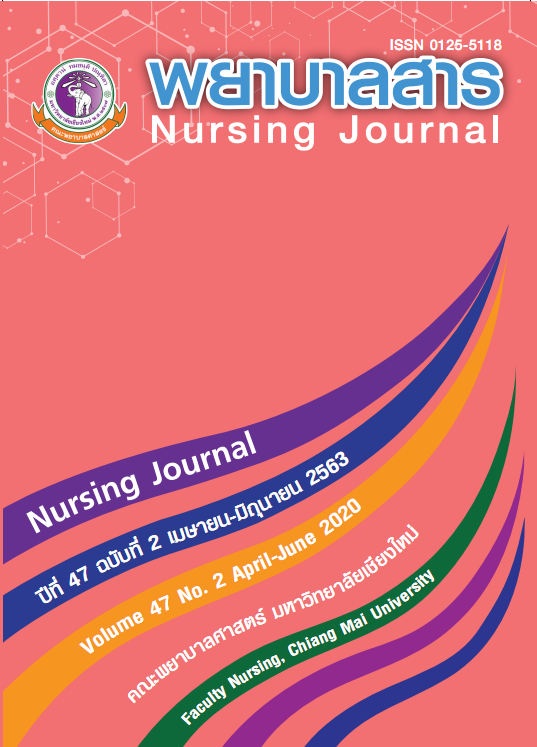Head Nurses’ Motivating Language and Registered Nurses’ Job Performance, Government University Hospitals
Keywords:
The motivating language, Job performance, Task performance, Contextual performance, Registered NursesAbstract
The motivating language of head nurses is one method to motivate nurse are best job performance. This correlational descriptive study aimed to determine the relationship between motivating language of the head nurses and the job performance of the nurses among nurses at government university hospitals. The sample included 366 registered nurses who were selected using the stratified random sampling method. Instruments were the Head Nurses’ Motivating Language Questionnaires by Prapasanobol (2007) and the Nursing Performance Scale by Greenslade and Jimmieson (2011) that was translated by the researcher. The Cronbach’ alpha coefficients of the Head Nurses’ Motivating Language Questionnaires and the Nursing Performance Scale were .94 and .95 respectively. Data were analyzed by using descriptive statistics and Spearman’s Rank Order Correlation.
The results of the study revealed the followings:
- The motivating language of head nurses as perceived by registered nurses at government university hospitals was at high levels. (= 3.79, S.D. = .65)
- Task performance and contextual performance of registered nurses at government university hospitals were at high levels. (= 58.27, S.D. = 7.37 and = 72.00, S.D. = 10.54 respectively)
- There was a statistically significant positive correlation between the motivating language of head nurses and the task performance and the contextual performance of registered nurses government university hospitals. (r = .347, p < .01 and r = .343, p < .01 respectively)
Results of the study can be used by nursing administrators to promote the use of the motivating language of head nurses in order to enhance the job performance of registered nurses at government university hospitals.
References
Auttamana, S. (2005). Organizational Behaviors: Theory and application. Bangkok: Thammasat printing house. (In Thai)
Awases, M. H., Bezuidenhout, M. C., & Roos, J. H. (2013). Factors affecting the performance ofprofessional nurses in Namibia. Curationis, 36(1), 108-115. Retrieved from http://dx.doi.org/10.4102/curationis.v36i1.108.
Changwang, C. (2011). Organizational Trust, Organization Citizenship Behavior and Job Performance of Professional Nurses at Nakhon Nayok Province’s Hospital (Master’s thesis, Kasetsart University). (In Thai)
Fathimath, M. (2012). Quality of Work Life and Job Performance Among Nurses in the Tertiary Care Hospital, Maldives (Master’s thesis, Chiangmai University).
Greenslade, J. H., & Jimmieson, N. L. (2007). Distinguishing between task and contextual performance for nurses: development of a job performance scale . Journal of Advanced Nursing, 58(6), 602–611.
Greenslade, J. H., & Jimmieson, N. L. (2011). Organizational factors impacting on patient satisfaction: A cross sectional examination of service climate and linkages to nurses’ effort and performance. International Journal of Nursing Studies, 48(10), 1188–1198. doi:10.1016/j.ijnurstu.2011.04.004.
Hilton, A., & Skrutkowski, M. (2002). Translating instruments into other languages: Development and testing processes. Cancer Nurse, 25(1), 1-7.
Jansin, J. (2008). Guideline for Conflict Management in State Hospitals in Samutprakan Province, Thailand: A Case Study of Complaints in Health Care Services. Quality of Life and Law Journal, 4 (2), 11-25. (In Thai)
Jantuma, J. (2009). Relationships between leadership, emotional intelligenceand happiness with performance of nurses, Phyathai 1 Hospital (Master’s thesis, Kasetsart University). (In Thai)
Kunaviktikul, W., Anders, R. L., Chontawan, R., Nantsupawat, R ., Srisuphan, W., Pumarporn, O.,Hanuchareonkul, S., & Hirunnuj, S. (2005). Development of indi cators to assess the quality of Nursing care in Thailand. Nursing and Health Sciences, 7(2), 273–280.
Maharaj Nakorn Chiang Mai Hospital. (2015). Faculty of Medicine Awarded: Article for public relationship. Retrieved from www.med.cmu.ac.th/research/Homepage /award/cmu_award58/cmu-awad58.html.
Mayfield, R. J., Mayfield, R. M., & Kopf, J. (1998). The effect of leader motivating language on subordinate performance and satisfaction. Human resource management, 37(2), 235-248.
Mayfield, R. J., & Mayfield, R. M. (2010). Leader-level influence on motivating language: A two-level model investigation on worker performance and job s atisfaction. International Business Journal, 20(5), 407-422.
Meessen, B., Musango, L., Kashala, J. P., & Lemlin, J. (2007). Reviewing institutions of rural health centres: the Performance Initiative in Butare, Rwanda. Tropical Medicine & International Health, 11(3), 1303-1317.
Mutumol, K. (2000). Work Empowerment and Competency in Nursing Practice among Staff Nurses in Maharaj Nakorn Chiang Mai Hospital (Master’s thesis, Chiangmai University). (In Thai)
Nantsupawat , R. (2000). Nursing Leadership in Organization. Chiangmai: Nopburee Printing. (In Thai)
Naresuan University Hospital. (2015). Employee of the “Kondee sri Kanapad”: News for public relationship. Retrieved from http://www.med.nu.ac.th/2008/newdetail_temp. ph p?IDn=03079. (In Thai)
Nursing Department, Maharaj Nakorn Chiang Mai Hospital. (2012). Registered Nurses’ s Job Description at Maharaj Nakorn Chiang Mai Hospital, Chiang Mai. Retrieved from www.med.cmu.ac.th /hospital/nis /jobdesc.html. (In Thai)
Pathomchaicoop, L. (2002). Relationships between motivation language of head nurses, nursing teamwork, effective followership of staff nurses, and effectiv eness of patient units, regional hospital and medical centers (Master’s thesis, Chulalongkorn University). (In Thai)
Pibulpawat, L. (2010). Job Stress, Emotional Intelligence and Job Performance of Profe ssional Nurse at Phyathai Hospital 2 (Master’s thesis, Kasetsart University). (In Thai)
Praparsanobol, S. (2007). Relationships between motivation language of head nurses, unitTeam Working, Communication Skill of Staff Nurses and Organizational Effectiveness, Government hospital Bangkok Metropolis (Master’s thesis, Chulalongkorn University). (In Thai)
Schwirian, P. M. (1987). Evaluation the performance of nurse: A multidimensional approach. Nursing Research, 27(6), 347-351.
Srisatidnarakul, B. (2007). The methodology in Nursing Research. Bangkok: UandI intermedia company. (In Thai)
Srivarinth, M. (2014). Relationships Relationships between Moti vation Language of Head Nurse and Nurses’ Productivity as Perceived by Professional Nurses, Police General Hospital. Journal of The Police Nurse, 6(1), 131-141. (In Thai)
Sullivan, J. J. (1988). Three role of language in motivation theory. The Academic Management Review, 13(1), 104-115.
Thailand Nursing and Midwifery Council. (2012). Nursing Strategic Planning 2012-2016. Retrieved from http://www.tnc.or.th/files/2009/12/page-27/__25473.pdf
Thailand Nursing and Midwifery Council. (2013). Professional Nursing Handbook, The Tambon Health Promoting Hospital. Retrieved from http://www.tnc.or.th/files/2014/05/book_n_journal-9000/__20762.pd
Wijarnpreecha, N. (2001). Emotional Intelligence and Job Performance of Operating Nurses in a Government Hospital (Master’s thesis, Chiangmai University). (In Thai)
Downloads
Published
How to Cite
Issue
Section
License
บทความที่ได้รับการตีพิมพ์เป็นลิขสิทธิ์ของวารสารพยาบาลสาร
ข้อความที่ปรากฏในบทความแต่ละเรื่องในวารสารวิชาการเล่มนี้เป็นความคิดเห็นส่วนตัวของผู้เขียนแต่ละท่านไม่เกี่ยวข้องกับมหาวิทยาลัยเชียงใหม่ และคณาจารย์ท่านอื่นๆในมหาวิทยาลัยฯ แต่อย่างใด ความรับผิดชอบองค์ประกอบทั้งหมดของบทความแต่ละเรื่องเป็นของผู้เขียนแต่ละท่าน หากมีความผิดพลาดใด ๆ ผู้เขียนแต่ละท่านจะรับผิดชอบบทความของตนเองแต่ผู้เดียว






